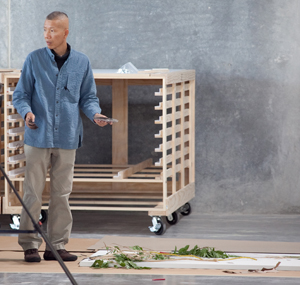
PARIS (AFP) – China’s new clout on the global art market, and its taste for home-grown works, is driving up the price of contemporary Chinese artists – forcing the Western art world to make space at the table for the rising stars.
Last year China became the world’s leading auction marketplace for fine art, after overtaking France, Britain and finally the United States in the space of five years, according to research by Artprice.
And China’s rise as an art hub is flipping the traditionallyWestern-dominated market on its head as wealthy collectors snap up art by their compatriots, fueling a surge in prices for Chinese artists.
“Chinese collectors are basically looking at Chinese art,” explained Barbara Pollack, author of a recent study titled “The Wild Wild East: an American art critic’s adventures in China.”
As a result five Chinese artists currently sit among the world’s top 10 as measured by combined sales at auction, overtaking giants like the U.S. popartist Jeff Koons, ranked third, or Britain’s Damien Hirst, ranked ninth by Artprice.
Taking a broader view, Chinese artists accounted last year for fully 45 of the world’s 100 top-selling art names.
Some of these are established figures, like Beijing-based Zeng Fanzhi, best known for his “Masks” collection of paintings, who was the world’s second best selling artist in the year to June 2011, just behind Jean-Michel Basquiat.
The late Chinese master Chen Yifei is ranked fifth while the gunpowder specialist Cai Guoqiang, who directed the special effects at the 2008 Beijing Olympics ceremonies, takes 32nd spot.
Scanning down the list, however, many names are unfamiliar to the Western eye, such as the painters Wang Yidong and Zhou Chunya – neither of whom enjoys major international renown – ranked seven and 10.
“There are names which are totally fueled by the Chinese market, some of them traditional ink painters, who are almost unheard of in the West,” said Pollack.
Few of these Chinese artists have so far been invited to show at Western art fairs, which remain weighted towards Europe and North America despite growing participation from Asia, Africa and Latin America.
“Some of these artists are outside of our tradition. Others have not yet gotten the museum attention from Western institutions that they clearly deserve, and that is hindering their acceptance in the West,” said Pollack.
Jennifer Flay, president of the FIAC contemporary art fair, one of the top events in Europe’s art calendar, which wrapped up Sunday in Paris, said she was looking to expand the Chinese presence at the event.
“There’s a lot of very interesting art emerging in China,” she said.
Of the 168 galleries present for this edition, however, just one was Chinese.
Shanghart brought along work by eight Chinese contemporary artists, including several who “play on Western concepts for inspiration,” a gallery spokeswoman told AFP at the fair.
From Shanghai artist Zhou Tiehai, for instance, there was a mosaic-like painting depicting French society, and a black-and-white pop-art piece inspired by Charlie Chaplin’s Modern Times, alongside a portrait of Mao Tse-tung in front of the statue of liberty, by Yu Youhan.
U.S. heavyweight The Pace Gallery staged an installation at FIAC of work by top Chinese artist Zhang Huan, featuring two giant Buddha heads made from materials recovered after the Cultural Revolution, and an ash painting made with burned temple incense.
And Galleria Continua had a 1999 work by Chen Zhen – Exciting Delivery – a wheel-mounted colossus made of bicycle tires and toy cars, on sale for $1.25 million.
Beyond that the Chinese presence was minimal.
Change is happening faster elsewhere in the West, according to Pollack, who says “every major New York gallery has a Chinese artist at this point,” while U.S. galleries such as Pace and Gagosian have all launched Chinese operations, as has London’s White Cube.
Some in the Western art world, however, appear to be betting that the current surge in prices for Chinese art is temporary.
Artprice’s report suggests “the Asia-Pacific region does not have the critical sophistication of Western demand” but that “this will probably change as art fairs and exhibitions refine Asian tastes.”
In other words, novice Chinese buyers are focusing on the “wrong” type of art, but Westerners will set them right and prices will eventually settle back down.
Pollack dismisses that notion.
“I think we still have a very Euro-centric view of what’s the best of contemporary art,” she said. “And the idea that we are going to teach them taste is very narrow minded.”
China turned over 390 million euros of contemporary art at auction in the year to June 2011, well ahead of the United States with 227 million euros, and auctioneers Christie’s and Sotheby’s are both investing heavily in the region.
“Many people in the West still think of the Chinese art market as a regional phenomenon,” Pollack said. “But the size of it is beginning to prove it can no longer be ignored. This market is only going to grow.”
“The fact Pace and Gagosian and White Cube realize they can’t survive without cultivating Chinese artists shows the power of Chinese taste.”


